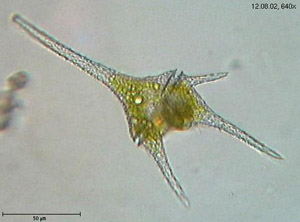Division Chrysophyta includes the lovely diatoms (approximately 10,000 species), the golden-brown algae (approximately 1,500 species), and the smaller group (approximately 600 species) of yellow-green algae. Chrysophyta are characterized by the presence of chlorophylls a and c; fucoxanthin, a yellow-brown pigment present in all except the yellow-greens; silicon-impregnated cell walls (lacking cellulose); and their storage of food as oil rather than starch.

Diatom

dinoflagellates |
![]()

